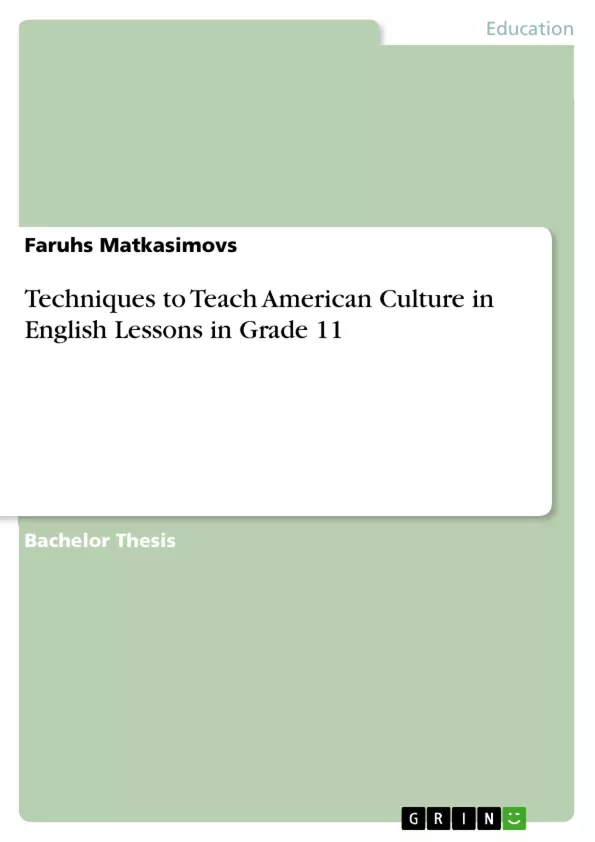The Diploma Paper explores techniques to teach American culture in English lessons in Grade 11. The author believes that teaching American culture, especially in the 21st century, is of high importance.
The chosen research method was a case study in a Riga School. Interviews, questionnaire, students' portfolios and feedback were chosen as data collection methods.
The data reflect that the use of the teaching techniques enhanced students’ intercultural skills. American culture contributed to Grade 11 students' ability to draw connections among ideas, justify a stand or decision as well as produce a new original work or point of view. Even though the research showed beneficial results, the author suggests carrying out further research to gather more data on the topic in other age groups.
Inhaltsverzeichnis (Table of Contents)
- INTRODUCTION
- 1. TEACHING CULTURE TO ENGLISH LANGUAGE LEARNERS
- 1.1 Defining Culture
- 1.2 Rationale to Teach Culture in the English Language Classroom
- 2. TEACHING AMERICAN CULTURE IN THE ENGLISH LANGUAGE CLASSROOM
- 3. TECHNIQUES FOR TEACHING AMERICAN CULTURE
- 4. CASE STUDY ON TEACHING AMERICAN CULTURE IN GRADE 11
- 4.1 Analysis of the Teachers' Interviews
- 4.2 Analysis of the Students' Questionnaire
- 4.3 Implementation of Techniques to Teach American Culture in English Lessons in Grade 11
- 4.4 Analysis of the Students' Portfolios
- 4.5 Analysis of the Students' Feedback
- CONCLUSION
- THESES
- BIBLIOGRAPHY
- APPENDICES
Zielsetzung und Themenschwerpunkte (Objectives and Key Themes)
The Diploma Paper aims to investigate effective techniques for teaching American culture in English lessons for Grade 11 students. The author argues that teaching American culture, particularly in the 21st century, is crucial for fostering intercultural understanding and promoting students' critical thinking skills.
- The importance of teaching culture in the English language classroom.
- The impact of American culture on language learning and intercultural skills.
- Effective techniques for teaching American culture in English lessons.
- The role of critical incidents and culture capsules in teaching American culture.
- The benefits of incorporating American culture in English lessons for Grade 11 students.
Zusammenfassung der Kapitel (Chapter Summaries)
The introductory chapter explores the significance of culture in language teaching and learning, highlighting its practical value and role in fostering cultural understanding. It emphasizes the importance of teaching American culture to promote intercultural skills and appreciation for diverse perspectives. The author argues that teaching American culture goes beyond language acquisition and encompasses understanding values, traditions, and societal structures.
Chapter 2 delves into the specific challenges and opportunities of teaching American culture in the English language classroom. It addresses the need for teachers to be knowledgeable about the country and its culture, particularly in light of potential misconceptions and stereotypes that students may encounter. The chapter explores the role of media and other factors in shaping students' perceptions of American culture.
Chapter 3 presents various techniques for effectively teaching American culture in English lessons. It examines methods that engage students, promote critical thinking, and facilitate intercultural awareness. The chapter discusses the use of critical incidents, culture capsules, and other pedagogical approaches for enhancing the teaching and learning process.
Chapter 4 focuses on a case study conducted in Riga English Grammar School, examining the implementation of techniques for teaching American culture in Grade 11. The chapter analyzes data collected through interviews, questionnaires, student portfolios, and feedback. It provides insights into the effectiveness of the techniques and their impact on students' intercultural skills and critical thinking abilities.
Schlüsselwörter (Keywords)
The study focuses on techniques for teaching American culture in English lessons, exploring key concepts such as intercultural skills, critical thinking, critical incidents, culture capsules, and the importance of fostering a deeper understanding of diverse cultures.
- Citation du texte
- Faruhs Matkasimovs (Auteur), 2016, Techniques to Teach American Culture in English Lessons in Grade 11, Munich, GRIN Verlag, https://www.grin.com/document/340234



